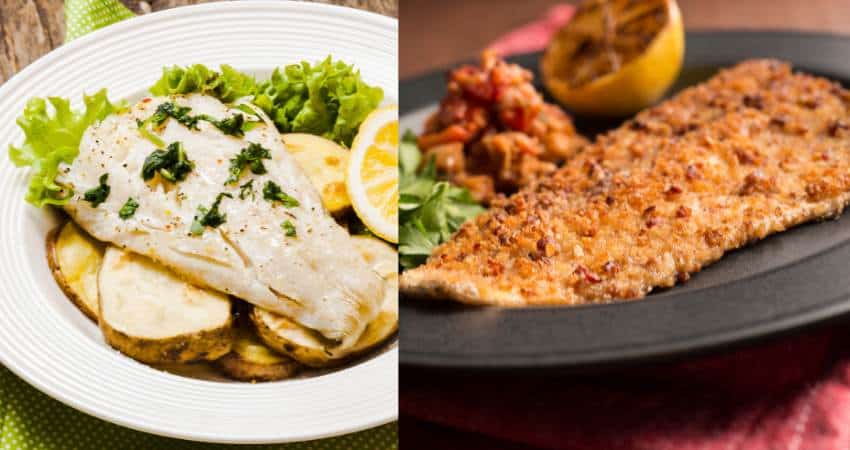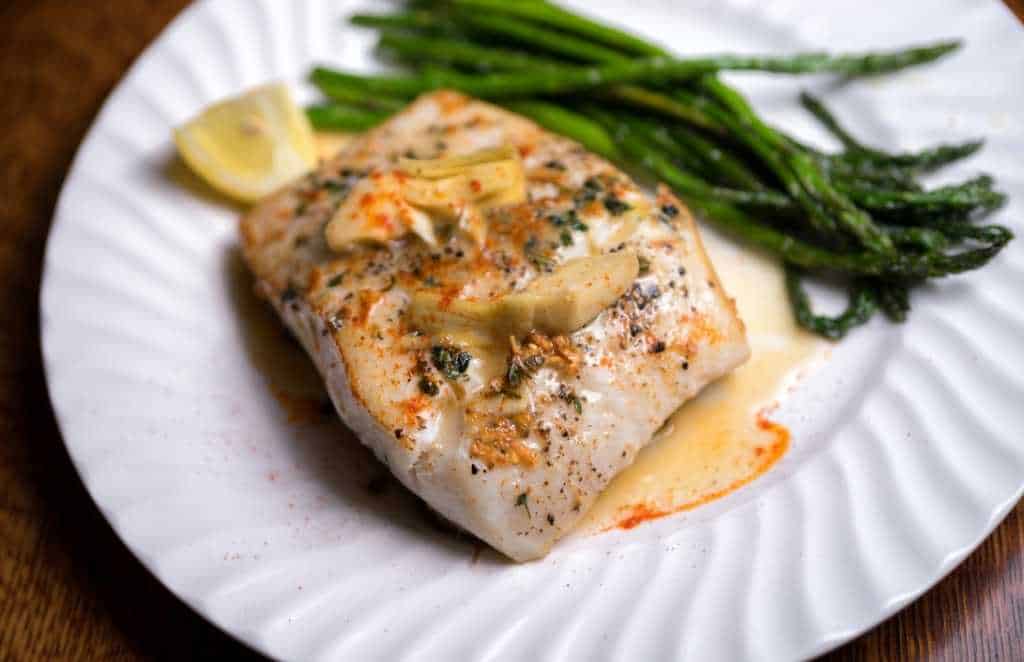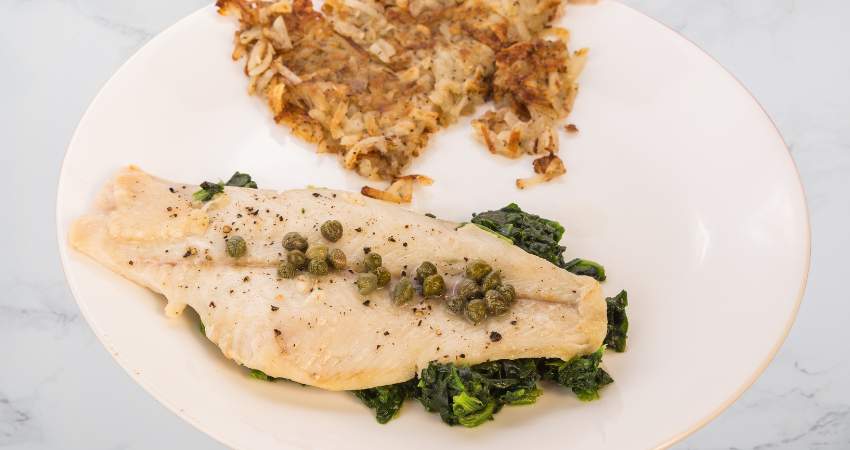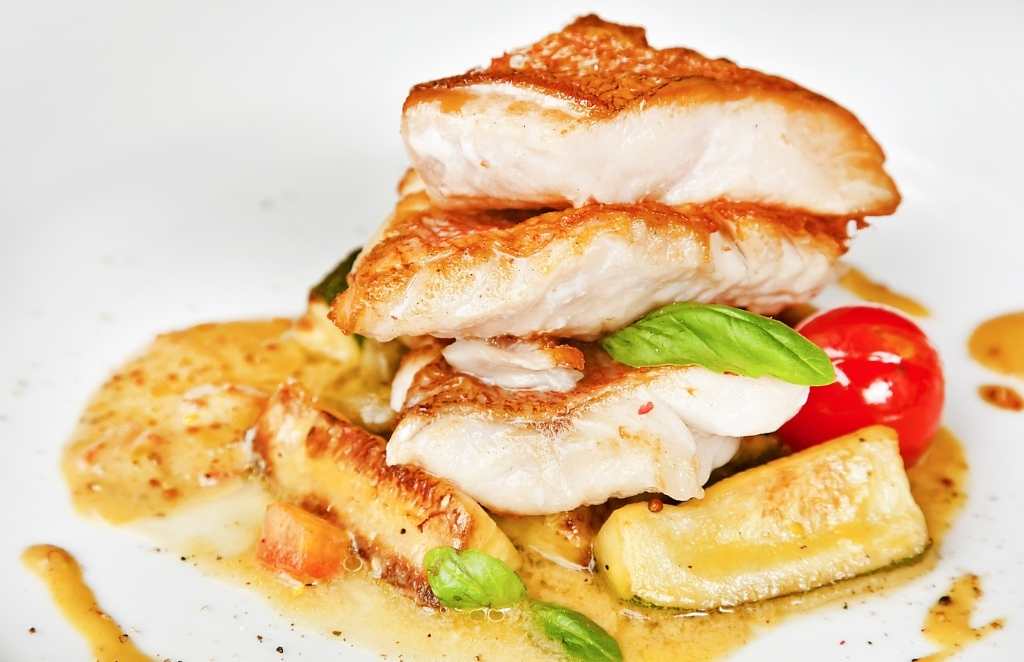Trout Replacements: The 12 Best Substitutes
Trout is a popular fish but there may be reasons someone would want to find a replacement. During my health coaching sessions many of my clients ask about alternatives for fish like trout. Therefore, what is a good substitute for trout?
The following are the best replacements for trout:
- Rainbow trout
- White Sea bass
- Chilean sea bass
- Bass
- Halibut
- Alaska pollock
- Flounder
- Tilapia
- Red grouper
- Atlantic mackerel
- Tuna
- Tilefish
This article will list the above options and compare their tastes, textures and cooking methods. In addition, I’ll examine and include a side-by-side comparison of their nutrients.
In addition to coaching clients about them, I’ve purchased, researched and used the alternatives in this article prior to, during and sometimes after writing this article.

Trout Replacements
1. Rainbow Trout
Why rainbow trout is a good option:
- It is a freshwater fish.
- It has a similar tender texture.
- Its taste is mild similar to brook trout and less fishy than brown trout.
- It has a similar number of calories and nutrients.
- It’s more affordable.
- Listed on the best choices for mercury list.
Cooking comparison:
- They can be cooked using similar methods like roasting, grilled, poached, broiled and fried.
- Finding similar size fillets shouldn’t be difficult.
Macro comparison
The following table is a side-by-side comparison of some nutrients contained per 3 ounces.
| Freshwater Trout, raw (3 ounces) | Rainbow Trout, raw (3 ounces) | |
| Calories | 109 | 101 |
| Protein | 16.9 g | 17.4 g |
| Total fat | 2.4 g | 2.9 g |
| Omega-3 | 0.56 g | 0.59 g |
| Potassium | 342 mg | 409 mg |
| Calcium | 28.8 mg | 57.0 mg |
Nutrient Resources12 ((New Zealand Food Composition Data: Trout, brown, flash, raw)) ((Cornell University: Trout Nutritional Information: Brook Trout, raw))3
I like using rainbow trout due to its milder taste. I’m not a big fan of a fishy taste so this one is enjoyable when it’s available in the store.
The following video explains how to cook rainbow trout.
2. White Sea bass
Why white sea bass is a good option:
- White sea bass has a similar tender texture.
- Its taste is mild similar to brook trout and less fishy than brown trout.
- It has fewer calories.
- Both fish have a similar price.
Cooking comparison:
- They can be cooked using similar methods like grilling, roasting, poached, broiled, baked and fried.
- Finding similar size fillets shouldn’t be difficult.
Macro comparison
The following table is a side-by-side comparison of some nutrients contained per 3 ounces.
| Freshwater Trout, raw (3 ounces) | Sea bass, raw (3 ounces) | |
| Calories | 109 | 82 |
| Protein | 16.9 g | 15.6 g |
| Total fat | 2.4 g | 1.7 g |
| Omega-3 | 0.56 g | 0.57 g |
| Potassium | 342 mg | 218 mg |
| Calcium | 28.8 mg | 8.5 mg |
Nutrient Resources ((USDA: Fish, sea bass, mixed species, raw))
I’ll often use white sea bass for the same reason as rainbow, it’s milder flavor.

3. Chilean Sea bass
Why chilean sea bass is a good choice:
- Chilean sea bass has a similar tender texture.
- Its taste is mild similar.
- It has fewer calories.
Cooking comparison:
- Both can be cooked using similar methods like grilling, roasting, poached, broiled, baked and fried.
- Finding similar size or larger fillets shouldn’t be difficult to match different weights in recipes.
Macro comparison
The following table is a side-by-side comparison of some nutrients contained per 3 ounces.
| Freshwater Trout, raw (3 ounces) | Chilean Sea bass, raw (3 ounces) | |
| Calories | 109 | 85 |
| Protein | 16.9 g | 15.7 g |
| Total fat | 2.4 g | 1.7 g |
| Omega-3 | 0.56 g | 0.36 g |
| Potassium | 342 mg | 215 mg |
| Calcium | 28.8 mg | 10.2 mg |
Nutrient Resources ((USDA: Chilean Seabass))

4. Bass
Bass is a name shared by many different species of fish. The more common freshwater bass are found in similar areas and waters. Those bass include spotted, smallmouth and largemouth bass.
Why bass is a good option:
- Smallmouth and spotted bass have a similar mild to sweet flavor as brook trout.
- Largemouth bass has a similar stronger to fishier flavor as brown trout.
- Bass has a firmer texture which holds together better while cooking.
- Bass has fewer calories.
Cooking comparison:
- They can be cooked using similar methods like grilled, baked, roasting, poached, broiled and fried.
- Bass fillets should be similar in size or larger.
Macro comparison
The following table is a side-by-side comparison of some nutrients contained per 3 ounces.
| Freshwater Trout, raw (3 ounces) | Freshwater Bass, raw (3 ounces) | |
| Calories | 109 | 97 |
| Protein | 16.9 g | 16.1 g |
| Total fat | 2.4 g | 3.1 g |
| Omega-3 | 0.56 g | 0.58 g |
| Potassium | 342 mg | 303 mg |
| Calcium | 28.8 mg | 68.0 mg |
Nutrient Resources ((USDA: Fish, bass, fresh water, mixed species, raw))
I love to use smallmouth bass due to its high omega-3s and milder taste.
5. Halibut
Why halibut is a good replacement:
- Halibut has a mild flavor similar to brook trout.
- It’s a good choice if a fishy taste is undesired.
- Halibut has a firmer texture.
- Halibut has fewer calories.
Cooking comparison:
- They can be cooked using similar methods like grilling, searing, poached, broiled and fried.
- Halibut is a large fish so finding large fillets shouldn’t be difficult.
Macro comparison
The following table is a side-by-side comparison of nutrients contained per 3 ounces.
| Freshwater Trout, raw (3 ounces) | Halibut, raw (3 ounces) | |
| Calories | 109 | 77 |
| Protein | 16.9 g | 15.8 g |
| Total fat | 2.4 g | 1.1 g |
| Omega-3 | 0.56 g | 0.18 g |
| Potassium | 342 mg | 370 mg |
| Calcium | 28.8 mg | 5.9 mg |
Nutrient Resources ((USDA: Fish, halibut, Atlantic and Pacific, raw))
I’ve been using halibut as an alternative when it’s available in the market. It’s one of my favorites due to its mild taste.

6. Alaska Pollock
Why Alaska pollock is a good choice:
- Pollock has a similar tender texture.
- Is taste is mild similar to brook trout and less fishy than brown trout.
- Has fewer calories.
- Alaska pollock costs less money.
- Is on the best mercury list.
Cooking comparison:
- They can be cooked using similar methods like baking, frying, poaching, roasting and sautéing.
- Pollock fillets will probably be smaller.
Macro comparison
The following table is a side-by-side comparison of some nutrients contained per 3 ounces.
| Freshwater Trout, raw (3 ounces) | Alaska Pollock, raw (3 ounces) | |
| Calories | 109 | 65 |
| Protein | 16.9 g | 14.6 g |
| Total fat | 2.4 g | 0.7 g |
| Omega-3 | 0.56 g | 0.21 g |
| Potassium | 342 mg | 281 mg |
| Calcium | 28.8 mg | 10.2 mg |
Nutrient Resources ((USDA: Fish, pollock, Alaska, raw))
This video shows you an easy way to cook Alaskan pollock.
7. Flounder
Flounder is the name used to describe many species distantly related. The following are the better-known flounder species:
- Atlantic Ocean
- Gulf flounder (Paralichthys albigutta)
- Summer flounder (Paralichthys dentatus)
- Southern flounder (Paralichthys lethostigma)
- Winter flounder (Pseudopleuronectes americanus)
- Atlantic Halibut (Hippoglossus hippoglossus)
- European waters
- European flounder (Platichthys flesus)
- Witch flounder (Glyptocephalus cynoglossus)
- North Pacific Ocean
- Halibut (Hippoglossus stenolepis)
- Olive flounder (Paralichthys olivaceus)
Why flounder is an option for trout:
- Has a mild to sweet flavor.
- Can be used for brown trout if a fishy flavor is undesirable.
- Has a similar tender texture.
- Flounder has almost half the number of calories.
- Is more affordable.
- Has similar levels of mercury.
Cooking comparison:
- They can be cooked using similar methods like baking, frying, poaching, roasting and sautéing.
- Flounder fillets will probably be smaller.
Macro comparison
The following table is a side-by-side comparison of some nutrients contained per 3 ounces.
| Freshwater Trout, raw (3 ounces) | Flounder, raw (3 ounces) | |
| Calories | 109 | 59 |
| Protein | 16.9 g | 10.5 g |
| Total fat | 2.4 g | 1.6 g |
| Omega-3 | 0.56 g | 0.23 g |
| Potassium | 342 mg | 136 mg |
| Calcium | 28.8 mg | 17.9 mg |
When flounder is available at the market, I’ll purchase it to use. I enjoy its mild to sweet flavor

8. Tilapia
Why tilapia is a good option:
- Tilapia is a good for brook trout due to its mild taste.
- Use tilapia for brown trout if a fishy flavor is undesirable.
- It has a similar tender texture.
- Has fewer calories.
- Is more affordable.
- Is listed on the best choices for mercury list.
Cooking comparison:
- They can be cooked using similar methods like roasting, grilled, poached, broiled and fried.
- Tilapia fillets will be smaller.
Macro comparison
The following table is a side-by-side comparison of some nutrients contained per 3 ounces.
| Freshwater Trout, raw (3 ounces) | Tilapia, raw (3 ounces) | |
| Calories | 109 | 82 |
| Protein | 16.9 g | 17.2 g |
| Total fat | 2.4 g | 1.4 g |
| Omega-3 | 0.56 g | 0.15 g |
| Potassium | 342 mg | 256 mg |
| Calcium | 28.8 mg | 8.5 mg |
Nutrient Resources ((USDA: Fish, tilapia, raw))
Tilapia may be one of the choices I use the most due to its availability.
Find out what fish are good options for sea bass in my article, Sea Bass Substitutes: 10 Healthy Alternatives.
9. Red Grouper
Why red grouper made this list:
- Red grouper has a mild flavor similar to brook trout.
- Its good to use for brown trout if a fishy taste is undesired.
- It has a firmer texture.
- Has fewer calories.
Cooking comparison:
- They can be cooked using similar methods like grilling, searing, poached, broiled and fried.
- Red grouper is difficult to overcook.
- Red grouper has smaller fillets and less cooking time.
Macro comparison
The following table is a side-by-side comparison of some nutrients contained per 3 ounces.
| Freshwater Trout, raw (3 ounces) | Grouper, raw (3 ounces) | |
| Calories | 109 | 78 |
| Protein | 16.9 g | 16.5 g |
| Total fat | 2.4 g | 0.86 g |
| Omega-3 | 0.56 g | 0.22 g |
| Potassium | 342 mg | 411 mg |
| Calcium | 28.8 mg | 23.0 mg |
Nutrient Resources ((USDA: Fish, grouper, mixed species, raw))
On one of my vacations in Clearwater, Florida, I ate grouper a good amount as it was available on almost every menu.

10. Atlantic Mackerel
There are various types of mackerel. When most people refer to mackerel, they are referring to Atlantic mackerel.
Why Atlantic mackerel made the list:
- Atlantic mackerel’s flavor is medium. Therefore, it’s closer to both types in taste.
- Mackerel has a firmer texture.
- It’s rich in omega-3 fatty acids.
- Mackerel costs less money.
- Atlantic mackerel has similar mercury levels.
Cooking comparison:
- Mackerel can be cooked using similar methods like grilling, searing, poached, baked, broiled and fried.
- Mackerel is difficult to overcook due to its oily, fat content.
- Atlantic mackerel may have smaller size fillets.
Macro comparison
The following table is a side-by-side comparison of some nutrients contained per 3 ounces.
| Freshwater Trout, raw (3 ounces) | Atlantic Mackerel, raw (3 ounces) | |
| Calories | 109 | 174 |
| Protein | 16.9 g | 15.8 g |
| Total fat | 2.4 g | 12.0 g |
| Omega-3 | 0.56 g | 2.13 g |
| Potassium | 342 mg | 267 mg |
| Calcium | 28.8 mg | 10.2 mg |
Nutrient Resources ((USDA: Fish, mackerel, Atlantic, raw))
One of my first choices because it’s the highest omega-3 content of all the fish on this list.
11. Tuna
Why tuna is a good option:
- Its flavor is strong and slightly fishy. Therefore, it’s closer in flavor to both types.
- Tuna has a mushy but firmer texture.
- Has fewer calories.
- It costs less money.
Cooking comparison:
- Tuna can be cooked using similar methods like grilling, searing, poached, baked, broiled and fried.
- Tuna fillets can vary in size depending on the type.
- Matching the same size fillet shouldn’t be difficult.
Macro comparison
The following table is a side-by-side comparison of some nutrients contained per 3 ounces.
| Freshwater Trout, raw (3 ounces) | Tuna, raw (3 ounces) | |
| Calories | 109 | 93 |
| Protein | 16.9 g | 21.0 g |
| Total fat | 2.4 g | 0.5 g |
| Omega-3 | 0.56 g | 0.09 g |
| Potassium | 342 mg | 375 mg |
| Calcium | 28.8 mg | 3.4 mg |
Nutrient Resources ((Nutrition Value: Tuna, raw, fresh))4
Avoid bigeye tuna which is high in mercury.
This video shows you an excellent way to cook tuna steak.
12. Tilefish
Why tilefish is a good substitution:
- Tilefish’s flavor is mild and sweet making it a good choice.
- Its good to use for brown trout if you’re looking to avoid a fishy flavor.
- Tilefish has fewer calories.
- It has a similar price.
Cooking comparison:
- Tilefish can be cooked using similar methods like frying, poached, baked, broiled and sauté.
- Tilefish fillets can vary in size.
- Matching the same size fillets shouldn’t be difficult.
Macro comparison
The following table is a side-by-side comparison of some nutrients contained per 3 ounces.
| Freshwater Trout, raw (3 ounces) | Tilefish, raw (3 ounces) | |
| Calories | 109 | 82 |
| Protein | 16.9 g | 14.9 g |
| Total fat | 2.4 g | 1.9 g |
| Omega-3 | 0.56 g | 0.49 g |
| Potassium | 342 mg | 368 mg |
| Calcium | 28.8 mg | 22.1 mg |
Nutrient Resources ((USDA: Fish, tilefish, raw))
Fish Substitute Poll
To conduct some original research and get the opinions of real people like you, I polled my readers, clients and members of some food groups. I asked them what was the best trout alternative?
- 29% said the best one was freshwater bass which was the winner of the poll.
- 12% said halibut which came in 2nd place.
- 9% said pollock which came in 3rd place.
If you have any questions about this article don’t hesitate to email us. You can find an email on our contact page.
Read Next – More Trout Articles!
Trout vs Bass – What’s The Difference? Let’s Compare
Brook Trout vs Brown Trout – Let’s Compare The Differences
Rainbow Trout vs Salmon: Is One Better?
Trout vs Salmon: Is One More Healthier Than The Other?
- USDA: Fish, trout, mixed species, raw [↩]
- USDA: Fish, trout, brook, raw, New York State [↩]
- USDA: Fish, trout, rainbow, wild, raw [↩]
- FDA: Fish, tuna, fresh, yellowfin, raw [↩]
